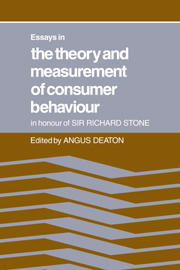Book contents
- Frontmatter
- Contents
- Foreword
- List of contributors
- Part one The analysis of commodity demands
- Introduction
- 1 Some Engel curves
- 2 Suggestions towards freeing systems of demand functions from a strait-jacket
- 3 Theoretical and empirical approaches to consumer demand under rationing
- 4 The independence transformation: a review and some further explorations
- 5 The analysis of consumption and demand in the USSR
- Part two The theory of index numbers
- Part three The consumption function and durable goods
- Part four Other aspects: fertility and labour supply
- Bibliography of Sir Richard Stone's works 1936–79
- Index of names
- Subject index
4 - The independence transformation: a review and some further explorations
Published online by Cambridge University Press: 05 November 2011
- Frontmatter
- Contents
- Foreword
- List of contributors
- Part one The analysis of commodity demands
- Introduction
- 1 Some Engel curves
- 2 Suggestions towards freeing systems of demand functions from a strait-jacket
- 3 Theoretical and empirical approaches to consumer demand under rationing
- 4 The independence transformation: a review and some further explorations
- 5 The analysis of consumption and demand in the USSR
- Part two The theory of index numbers
- Part three The consumption function and durable goods
- Part four Other aspects: fertility and labour supply
- Bibliography of Sir Richard Stone's works 1936–79
- Index of names
- Subject index
Summary
Introduction
The objective of this chapter is to discuss the relationship between the technique of principal components, first applied to economic data in the pioneering paper by Stone (1947), and the analysis of consumer demand.
The purpose of principal component analysis in statistics is to formulate a set of variables that are in some way ‘more basic’ than the observed variables. Factor analysis has a similar objective. Starting in 1956, Gorman and his associates (Boyle et al., 1977; Gorman, 1956; 1959; 1976b) applied these statistical techniques to consumer demand in order to assess the consumer's basic wants, while Lancaster (1966, 1971) and Becker (1965) pursued similar goals by extending the economic theory of the consumer rather than using statistical tools. The independence transformation, which originated with Theil (1967; 1975–76; 1977), Brooks (1970), and Laitinen and Theil (1978), is related to both approaches and is in fact ‘between’ them. The transformation requires no extension of the theory of the utility-maximizing consumer, although it can handle such extensions without difficulty (see the example on leisure in section 2). At the same time, the transformation has a simple statistical interpretation, viz., that of a constrained principal component transformation.
To provide adequate motivation, we discuss some examples in section 2. Sections 3 and 4 describe the preference independence transformation and the underlying differential approach to consumption theory. Section 5 gives a brief discussion of similar results in the theory of the firm.
- Type
- Chapter
- Information
- Essays in the Theory and Measurement of Consumer Behaviour: In Honour of Sir Richard Stone , pp. 73 - 112Publisher: Cambridge University PressPrint publication year: 1981



